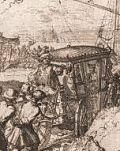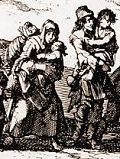
 | The German Huguenot Museum in Bad Karlshafen |
 |
History - 7. The flight of the Huguenots1. How the Huguenots got their name For religious freedom On the flight with all belongings From the outset, it is important to emphasize that the Huguenots were not driven out of France. On the contrary, in October 1685 in the Edict of Fontainebleau Louis XIV forbade his Protestant subjects to leave the country. Onle the Reformed ministers had to leave France within two weeks, if they were not perpared to convert to Catholicism. It is also important to stress that Huguenots were not leaving for economic reasons, i.e. to find more favourable living conditions in foreign parts. As a rule, they were leaving stable financial circumstances and had no conception of what awaited them in their land of refuge. The only reason they had for leaving was their desire to find a haven where they could practise their faith freely without being persecuted. The Huguenots were religious refugees. Not alone on their flight Reformed refugees The flight of French-speaking Reformed Protestants began in the 16th century. The first refugees were Walloons from the Netherlands, fleeing from the Spanish occupation forces. They found refuge in particular along the Rhine, in Wesel, Cologne, Frankfurt, Hanau and in the Palatinate. The Polish reformer John á Lasco (around 1500-1560) founded a Dutch Reformed Congregation in the town of Emden in 1544. The Wallons were followed by the Huguenots. They left their French homeland in growing numbers in the course of the reign of Louis XIV as the repression intensified. When the "Sun King" revoked the Edict of Nantes in Ocotober 1685 removing the last vestiges of religious freedom, around 170,000 Protestants left France within a few months. The next to take the road to exile were the Waldensiens in the Duchy of Savoy. They were expelled by the Duke at the behest of Louis XIV. In 1702 the Protestants of Orange had to flee when the principality was annexed by Louis XIV. Destinations Refugees crossed the Jura Mountains Although the borders of France were strictly controlled, most of the fugitives managed to escape to Protestant countries. Some of them wrote about the hardship and anguish they suffered en route. They headed for various destinations. From the north of France they crossed the border into Holland. From the west they boarded ships for England. The great majority of the Huguenots lived in the south of France and many of them fled to Switzerland. The Swiss cantons negotiated with German princes as Switzerland was too overpopulated to keep them. Arrival in Germany A flying Huguenot family Many headed for Frankfurt on Main where they received assistance and could contact the agents of the German princes who were interested in attracting suitable settlers. Their destinations had to be decided and transport had to be organized. The exertions and privations of their flight can hardly be imagined. Many refugees, especially old people and children, took ill and died of hunger, cold and deficiency symptoms en route. The problems and deprivations of the early years in the host countries explain why the death rate continued to be high. It took years and often decades for the refugees to settle down to a normal life. |
© The German Huguenot Museum 2025 |